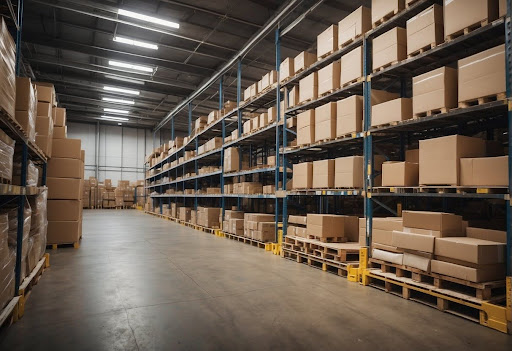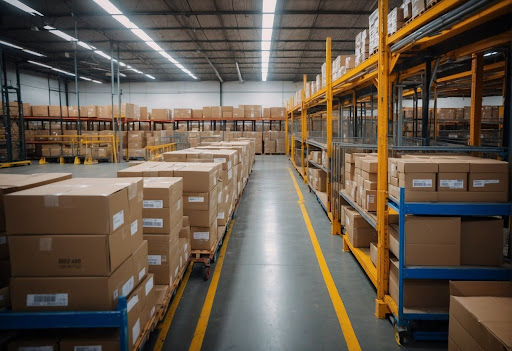In the fast-paced world of eCommerce, ‘What is order fulfilment?‘ is a question at the heart of customer satisfaction and business success.
It’s more than just sending out packages; it’s about precision, efficiency, and the delicate balance of managing inventory, processing, and shipping. This article discusses the critical stages of the entire order fulfilment process, exploring the nuances that set thriving eCommerce businesses apart. Discover the art of turning logistical challenges into opportunities for growth and customer loyalty.
Let’s jump into the basics first.
In this article
Understanding order fulfilment

Order fulfilment is a crucial component in any eCommerce business, encompassing all the steps from receiving an order to delivering it to the customer. Precision in this process is key as it directly impacts customer satisfaction and operational efficiency.
Defining order fulfilment
Order fulfilment refers to the sequence of operations involved in completing a customer’s purchase. The process includes several key stages: receiving inventory, processing the order, picking items, packing them, and shipping. Each stage must be executed flawlessly to meet the customer expectations inherent in eCommerce transactions.
The order fulfilment process
The fulfilment process begins when a customer places an order and ends upon receipt of their purchase. Here is an overview of the typical stages:
- Receiving inventory: Items are received from manufacturers or suppliers and are then stored in a warehouse or fulfilment centre.
- Order processing: As soon as an order is placed, the details are verified and processed.
- Picking: Warehouse staff locate and retrieve the ordered items from their respective places.
- Packing: Items are carefully packaged, ensuring they are ready for shipment without damage.
- Shipping: The order is handed over to a courier service for delivery to the customer’s address.
Each of these stages can be further fine-tuned with strategies to enhance efficiency and accuracy.
Importance in eCommerce
In eCommerce, the effectiveness of the fulfilment process is a direct reflection of the business’s commitment to customer service. A streamlined order fulfilment strategy is essential for ensuring that products are delivered promptly and accurately, thereby maintaining high levels of customer satisfaction and a positive business reputation. Additionally, an optimized and efficient order fulfilment process can lead to reduced operational costs and improved overall business performance.
In-house vs third-party fulfilment

When considering order fulfilment service options for a business, it is essential to understand the differences and impacts of in-house operations versus engaging a third-party logistics provider. Deciding between the two can significantly influence the efficiency of order fulfilment services and overall customer satisfaction.
What is in-house fulfilment?
In-house fulfilment involves a company managing its inventory storage, packing, and shipping processes internally. Generally, the business will have its warehouse or storage space where it houses inventory and conducts the order processing from start to finish.
Pros and cons of in-house fulfilment
- Pros:
- Complete control over inventory and order management.
- Direct oversight of shipping and handling processes.
- Cons:
- Requires significant investment in space and technology.
- Limits scalability when order volumes increase.
What is third-party logistics (3PL)?
Third-Party Logistics (3PL) refers to outsourcing fulfilment processes to an external fulfilment provider. These fulfilment providers specialize in warehousing, inventory management, and shipping services, which they offer to multiple eCommerce businesses.
Pros and cons of outsourcing fulfilment
- Pros:
- Access to expertise and advanced fulfilment technology in a fulfilment centre.
- The ability to scale operations flexibly with business growth.
- Cons:
- Less direct control over handling and storage operations.
- Potential for less brand-specific packaging experience.
Inventory management and storage

Effective order fulfilment is highly dependent on supply chain management and the efficient handling of inventory, from the moment items arrive at the warehouse to the time they are dispatched. Inventory management within this sphere is about maintaining the optimal level of stock, minimizing holding costs, and ensuring a smooth supply chain. Storage is critical to safeguarding inventory quality and accessibility, with a particular emphasis on organization, security, and proper environmental conditions.
Inventory receiving and storage
Once inventory arrives at a warehouse, it needs to be logged, inspected, and strategically stored. Skilled workers typically handle inventory receiving, ensuring each item matches the purchase order specifications and is free from damage. Upon verification, items are stored with two key objectives: preserving their condition and facilitating easy access. Storage is planned around various factors, including the size and type of inventory, as well as its turnover rate, to make sure fast-moving items are readily available.
- Check-in process: Verify SKU numbers and quantities.
- Inspection: Assess for damage and quality.
- Strategic placement: Store items based on turnover rate and accessibility needs.
Warehouse management systems
A warehouse management system (WMS) is an essential tool in modern inventory management. These sophisticated software systems provide real-time data on inventory levels, which is vital for fulfilling orders accurately and efficiently. WMS functionality often includes:
- Tracking items through SKUs and barcodes.
- Optimizing warehouse layout to speed up order processing times.
- Automating tasks such as reorder notifications.
The use of a WMS facilitates a data-driven approach, whereby inventory is not just accounted for, but analyzed to predict trends and improve operations. It is the technological backbone that integrates with other systems to create a synchronistic environment for managing all warehouse activities.
Just-in-time inventory
Just-in-time (JIT) inventory management is a strategy that aligns inventory orders with production schedules and actual sales data, minimizing warehousing costs by reducing stock levels. Implementing JIT effectively:
- Reduces waste by avoiding overstocking.
- Increases efficiency and reduces inventory holding costs.
- Requires precise synchronization between suppliers, production schedules, and customer demand.
To successfully apply a just-in-time inventory approach, businesses must have a robust understanding of their supply chain and a WMS that can handle the complex demands of tracking and stocking items only as they are needed. This precision-driven strategy necessitates a high level of confidence in supplier reliability and production scheduling accuracy.
Picking, packing, and shipping

The efficiency of any fulfilment operation hinges directly on the intricacies of picking, packing, and shipping. These crucial steps ensure that customers receive their orders promptly and accurately, reflecting the backbone of successful order fulfilment.
Picking process in fulfilment
The picking process begins when an order is received; it involves locating and collecting the ordered items from the warehouse. Accuracy is critical in this step to prevent errors down the line. Various strategies such as zone, wave, or batch picking are implemented to streamline the process and reduce the time between an order being placed and shipped.
Packing orders for shipment
Once items are picked, the packing phase ensures their protection during shipping. This involves selecting the appropriate packaging materials and boxes that fit the items snugly without wasting space. Efficient packing reduces both shipping costs and materials, as well as the risk of damage.
Choosing the right shipping carriers
The final stage is selecting a suitable carrier to deliver the package to the customer. Choices are made by fulfilment companies based on factors such as shipping costs, reliability, and delivery speed. Some fulfilment operations negotiate rates with multiple shipping carriers to offer the best balance of cost and service, ensuring customer satisfaction.
Customer experience and service
Order fulfilment directly impacts customer experience by shaping the delivery, communication, and support a customer receives. When these elements are effectively managed, they lead to higher customer satisfaction and loyalty.

Delivery experience and timely delivery
Customers expect their orders to be delivered promptly and in good condition. Timely delivery is a cornerstone of a positive delivery experience, and customer satisfaction often hinges on meeting or exceeding delivery timeframes promised at the purchase time. Optimal order fulfilment practices ensure that delivery is not only fast but also secure, contributing to a customer’s overall experience.
Handling returns and returns processing
An effective returns processing system is critical for maintaining customer trust. When customers initiate a return, they seek an assurance of a seamless process. Handling returns with care by providing clear instructions, and swift acknowledgments enhances customer service quality. The ability to process returns quickly resonates with the customers’ need for convenience, greatly affecting their perception of the service.
Communication and customer support
Transparent and proactive communication is vital throughout the order fulfilment process. From confirmation emails to delivery notifications, customers appreciate being informed. Equally important is responsive and helpful customer support ready to address any issues or questions. High-quality communication and support reinforce the reliability of a company, reflecting positively on the customer experience.
Technological solutions and innovations

In the realm of order fulfilment processes, constant technological advancements have paved the way for efficient and eco-friendly solutions. These innovations are crucial for eCommerce businesses to stay competitive and manage the sales process effectively.
Order fulfilment software advancements
Modern order fulfilment software provides a suite of tools that streamline supply chain management. For example, Enterprise Resource Planning (ERP) systems integrate various business processes into a single, coherent system, improving visibility and coordination across the organization. Key features include:
- Real-time inventory tracking.
- Automated order processing.
- Integrated shipping and logistics solutions.
These software advancements are changing the game for businesses, making complex fulfilment tasks more manageable and less prone to error.
Impact of artificial intelligence
Artificial Intelligence (AI) has a significant role in refining the technology used in order fulfilment.
- AI-driven analytics predict inventory needs and optimize stock levels.
- Machine learning algorithms improve route planning, reducing shipping times and costs.
By incorporating AI, companies achieve a more predictive, reactive approach to customer demand and shipping logistics.
Eco-friendly packaging and practices
The trend toward sustainability is influencing the order fulfilment business with a move towards eco-friendly packaging and practices.
- Use of biodegradable and recycled materials.
- Implementation of green warehousing strategies.
This focus not only benefits the environment but also addresses consumer demand for sustainable business practices, making it a win-win for the present and future markets.

